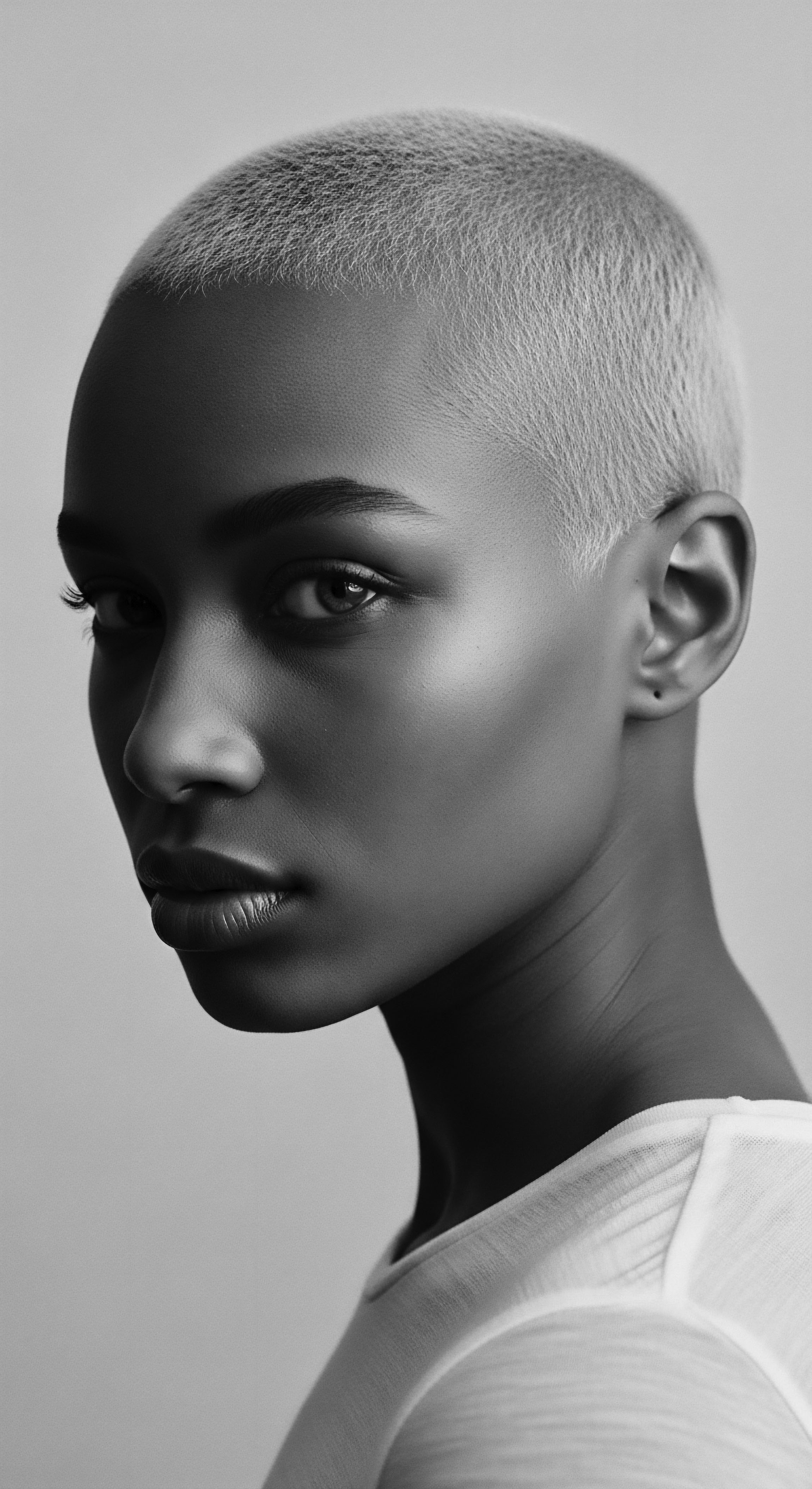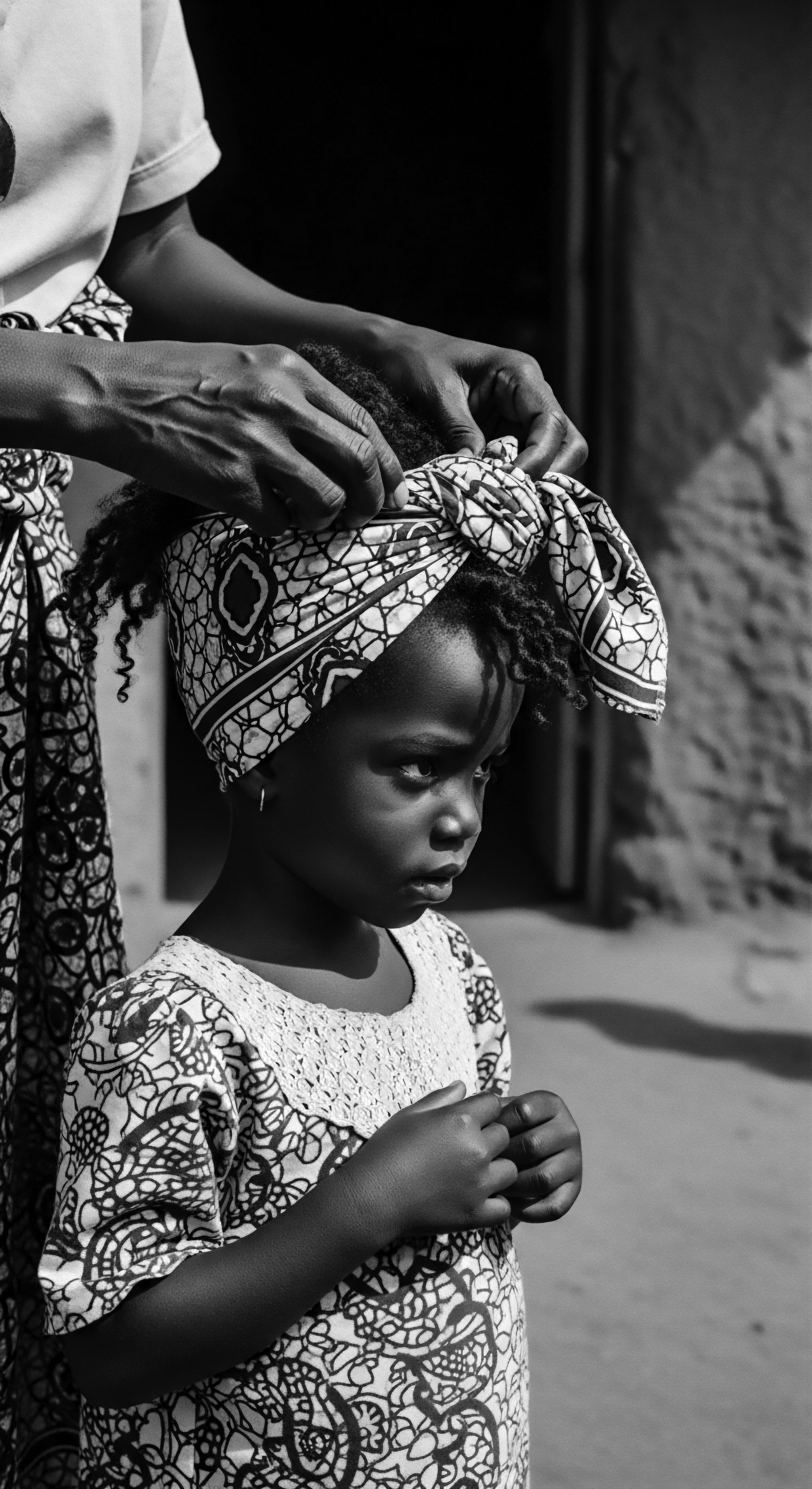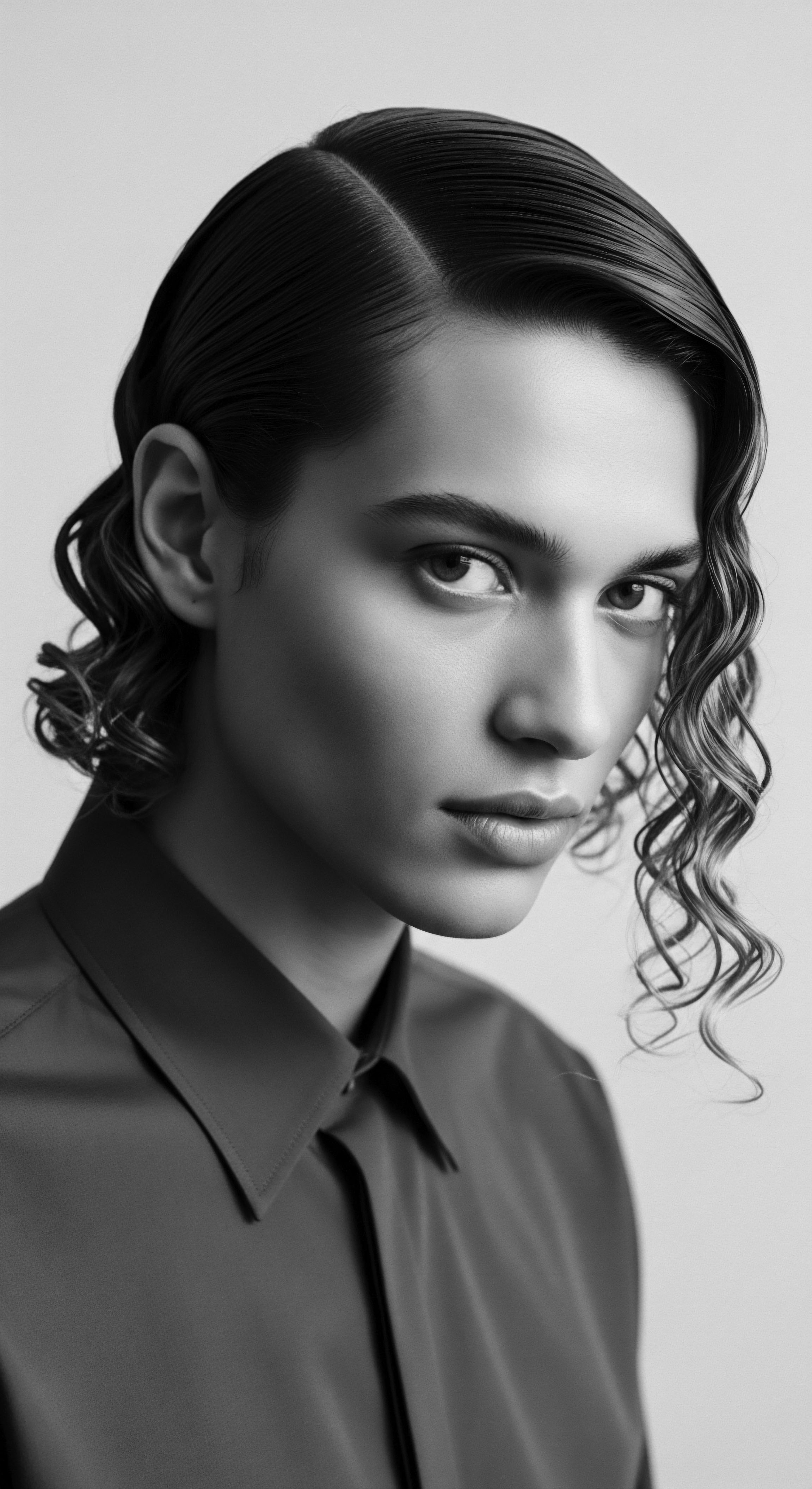
Fundamentals
The designation ‘satin head covering’ points to a specific textile weave employed in articles worn upon the head, designed primarily for the care and keeping of hair, particularly textured hair. At its simplest, this definition describes a fabric surface that offers a notably smooth contact, standing apart from materials like cotton or wool, which possess more abrasive textures. This smoothness is a key property, lending itself to the preservation of hair health and style.
When discussing a satin head covering, one is considering a piece of cloth, often shaped as a bonnet, scarf, or pillowcase, crafted with this characteristic weave. The inherent slipperiness of satin provides a gentle environment for hair, allowing strands to glide rather than snag.
From a foundational perspective, the very notion of a satin head covering aligns with a long-standing human endeavor to protect and maintain hair. Throughout generations, people have sought ways to shield their tresses from environmental elements and the rigors of daily life. The application of satin in this context represents an advancement in this protective care, utilizing a textile engineered for minimal friction.
Its surface permits hair to retain its natural configuration, reducing the likelihood of tangles and breakage. This simple yet profound function underpins the contemporary appreciation for satin head coverings as a staple in mindful hair regimens.

The Fabric’s Touch ❉ A Basic Understanding
The core of satin’s efficacy stems from its distinct weave, which arranges fibers in a way that creates a smooth, lustrous surface. While the term ‘satin’ often conjures images of luxurious silk, it is crucial to recognize that satin refers to the weaving technique itself, not the material. Many satin head coverings are made from synthetic fibers, such as polyester or nylon, which nonetheless replicate the desired smooth surface. Silk, a natural protein fiber, also frequently utilizes a satin weave, offering an even more refined smoothness and inherent benefits, but synthetic satin still delivers substantial advantages over coarser fabrics for hair protection.
Satin’s smooth surface reduces friction, safeguarding textured hair from tangles and breakage.
For individuals new to the world of specialized hair care, particularly those with delicate or curly hair patterns, the switch to a satin head covering often brings immediate, discernible improvements. Traditional pillowcases woven from cotton, for instance, absorb moisture readily and create considerable friction. This can strip hair of its vital hydration and disrupt the cuticle layer, leading to frizz and knots.
A satin surface, in contrast, creates a less absorptive and gentler interaction with the hair, preserving its inherent moisture and reducing mechanical stress. This fundamental protective quality is why satin head coverings have become a widely recommended item for maintaining hair integrity and appearance, especially during sleep.

Intermediate
Moving beyond the elemental properties, the meaning of a satin head covering deepens significantly when viewed through the historical and cultural experiences of textured hair, particularly within Black and mixed-race communities. This object, seemingly simple, carries a rich historical weight and serves as a conduit to ancestral wisdom. Its designation extends beyond mere fabric to signify a tradition of care, resilience, and identity. The smooth surface of satin, whether on a bonnet or scarf, serves as a tangible link to generations who understood the delicate needs of their hair.

Ancestral Echoes ❉ The Protective Mantle
The practice of covering hair for protection is an ancient one, observed across diverse African societies long before the contemporary adoption of satin. Archaeological evidence from the Kingdom of Ghana (300-1200 CE) reveals early traditions of headwrap use, crafted from locally woven textiles. These early wraps shielded against harsh sun, dust, and wind. The deep cultural heritage associated with head coverings meant they served practical purposes and conveyed social significance, including status, marital condition, or religious observance.
The introduction of silk, and later satin, into these practices represents an evolution of this protective intention. While silk production originated in ancient China, its spread along trade routes meant various cultures adopted its use for hair care due to its smooth texture. In some regions, silk headwraps, known as “gele” in Nigeria or “duku” in Ghana, were worn for ceremonial occasions, reflecting cultural lineage and personal style. The choice of material, and specifically the satin weave, became an informed decision, a gentle nod to the needs of hair prone to tangles and dryness.
The satin head covering holds within its fibers a living history of cultural reclamation.

A Legacy of Resistance and Self-Preservation
The true cultural significance of head coverings for textured hair, including those made of satin, intensified dramatically during the transatlantic slave trade and its aftermath. Stripped of possessions and ancestral practices, enslaved African women found ways to maintain remnants of their hair traditions. Head coverings, initially enforced by oppressors to signify status and shame Black hair, were ingeniously transformed into expressions of dignity and resistance.
One particularly poignant historical example manifests in the Tignon Laws of 18th-century Louisiana. These laws mandated that free Black women publicly cover their hair to differentiate them from white women and signify a lower social status. However, these resourceful women defied the oppressive intent, transforming the mandated headwraps—known as ‘tignons’—into elaborate, vibrant fashion statements using luxurious fabrics, including, where possible, silk and satin.
This act of sartorial insurgency asserted their autonomy and pride, repurposing a tool of subjugation into a symbol of identity and beauty. The continued use of satin head coverings within Black communities today carries echoes of this historical defiance and the enduring commitment to self-preservation and hair health.
| Era Ancient African Societies (3000 BCE – 1200 CE) |
| Purpose and Cultural Context Protection from elements (sun, dust, wind); indication of social standing, marital status, or spiritual connection. |
| Material Significance (including Satin's Place) Locally woven textiles, often coarse; laid the foundation for understanding hair protection. |
| Era Transatlantic Slave Trade & Colonial Eras (16th-19th Century) |
| Purpose and Cultural Context Forced hair covering by slaveholders to dehumanize and control; later reclaimed as symbols of resistance, dignity, and cultural preservation. |
| Material Significance (including Satin's Place) Scraps of fabric, handkerchiefs, cotton rags; the yearning for smoother, hair-preserving materials like silk/satin became evident as availability allowed. |
| Era Post-Slavery & Early 20th Century |
| Purpose and Cultural Context Continued practical use for hair preservation (especially for chemically straightened styles); evolving social meanings. |
| Material Significance (including Satin's Place) Increased use of silk or satin at home to maintain styles and reduce friction, marking a shift towards informed hair protection. |
| Era Civil Rights Era & Natural Hair Movement (Mid-20th Century – Present) |
| Purpose and Cultural Context Reclamation of Afrocentric styles; headwraps and bonnets became powerful symbols of Black empowerment, cultural pride, and connection to ancestry. |
| Material Significance (including Satin's Place) Satin and silk become preferred materials for bonnets, scarves, and pillowcases, scientifically acknowledged for their benefits to textured hair. |
| Era This progression illustrates how the head covering, and eventually satin head coverings, became deeply embedded in the cultural journey of textured hair. |
Beyond the grand historical narratives, the personal meaning of these coverings persists. Many individuals in Black and mixed-race communities speak of the nightly ritual of tying on a satin bonnet or wrapping their hair in a satin scarf as a moment of self-care, a quiet act of tending to their heritage. This gentle wisdom, passed through generations, understands that hair is not merely an adornment; it is a sensitive part of oneself, deserving of diligent, protective care. The smooth caress of satin becomes a symbol of this tender attention, a daily affirmation of one’s hair legacy.

Academic
The academic understanding of a satin head covering transcends its everyday definition to encompass a complex interplay of material science, historical sociology, and the psychophysiology of hair health, particularly in the context of afro-textured hair. The term designates a textile application specifically engineered to mitigate mechanical stress and moisture loss, thereby serving as a critical element in the maintenance of hair integrity and promoting scalp wellness, especially for hair types characterized by complex coiling patterns. This multifaceted interpretation is grounded in empirical observations and historical documentation, revealing a deeply resonant connection to ancestral practices and contemporary scientific validation.

Material Science and Hair Biophysics ❉ Echoes from the Source
The intrinsic value of satin for hair protection stems from its unique weave structure. Unlike plain weaves, which interlace warp and weft threads in a simple over-under pattern, the satin weave typically floats warp yarns over four or more weft yarns, creating a surface with fewer interlacing points. This construction minimizes friction between the fabric and the hair shaft. Textured hair, with its inherent helical or coily structure, is particularly susceptible to mechanical abrasion.
Each bend and coil presents a point where friction can cause the outermost protective layer, the cuticle, to lift or fracture. This phenomenon leads to increased frizz, split ends, and ultimately, breakage. Studies investigating the kinetic coefficient of friction for various textile weaves confirm that satin structures exhibit significantly lower frictional resistance compared to common materials like cotton.
Furthermore, the hygroscopic properties of textiles play a substantial role in hair health. Cotton, a natural cellulosic fiber, is highly absorbent, drawing moisture away from the hair strands and the scalp. For hair types already predisposed to dryness, such as afro-textured hair—which possesses an elliptical cross-section and fewer cuticle layers, making it more prone to moisture evaporation—this moisture stripping by cotton pillowcases or coverings can exacerbate brittleness. Satin, especially when composed of synthetic fibers like polyester or nylon, exhibits a lower absorbency profile.
While silk (a natural protein fiber) offers superior moisture retention due to its protein composition and breathability, synthetic satin still significantly surpasses cotton in preserving the hair’s natural hydration and applied conditioning treatments. This fundamental difference in moisture exchange is a cornerstone of the satin head covering’s efficacy, directly contributing to the hair’s lipid barrier integrity and overall suppleness.
Consider the Hair Cuticle, a delicate arrangement of overlapping scales, much like shingles on a roof. When this cuticle is smooth and lies flat, hair reflects light, feels soft, and retains moisture. Rough fabrics, through repeated contact during sleep or movement, can abrade these scales, lifting them and creating a porous surface.
This physical disruption not only diminishes the hair’s luster but also accelerates moisture egress, leaving the strand vulnerable to environmental aggressors and breakage. The consistent, low-friction environment provided by a satin surface actively works to maintain the cuticle’s integrity, thereby supporting the hair’s natural resilience and growth cycles.

Sociocultural Reclamations ❉ The Tender Thread
Beyond its biophysical attributes, the meaning of the satin head covering is inextricably linked to the complex psychosocial landscape of Black and mixed-race hair experiences. Historically, hair discrimination, deeply rooted in Eurocentric beauty standards, sought to denigrate afro-textured hair, associating its natural forms with unattractiveness or unmanageability. During the era of slavery, African hair was often forcibly cut, serving as a tool of dehumanization and cultural erasure.
Laws were even enacted, such as the aforementioned Tignon Laws, to control the appearance of Black women’s hair. This history of oppression instilled a deep-seated cultural significance in hair coverings, transforming them from mere protective articles into potent symbols of resistance, self-worth, and cultural continuity.
The selection of satin for these coverings represents an evolution within this continuum of cultural agency. As Black women navigated the pressures to conform to dominant beauty norms—often resorting to chemical straightening—the use of satin at home became a silent act of preservation, a method to protect styles and intrinsic hair health. With the advent of the Natural Hair Movement, particularly prominent since the early 2000s, satin head coverings became a visible symbol of embracing one’s inherent hair texture.
This movement consciously rejects Eurocentric ideals, advocating for the acceptance and celebration of natural hair. The satin bonnet, scarf, or pillowcase, therefore, is not simply a utilitarian object; it embodies a profound declaration of identity, a reclamation of ancestral wisdom, and a deliberate act of self-care that acknowledges the historical journey of textured hair.
Satin head coverings serve as a bridge between scientific understanding of hair care and the deep-seated heritage of hair protection within Black communities.
The psychosocial impact of hair care practices within the Black community is well-documented. Studies reveal that a majority of African American women report a history of excessive hair breakage or shedding, with a significant number experiencing frustration related to hair grooming. These challenges underscore the importance of protective measures. While direct causal links between satin use and reduced hair loss or increased growth require more extensive longitudinal studies, the demonstrated reduction in friction and moisture loss provided by satin unequivocally minimizes mechanical stress on hair strands.
This reduction in stress is a foundational element in preventing damage that can lead to thinning and breakage, thereby supporting overall hair health and fostering a more positive hair experience. The adoption of satin head coverings can thus be viewed as a proactive health intervention, deeply connected to historical practices of safeguarding hair.
The contemporary meaning of satin head coverings is a synthesis of ancestral ingenuity and modern scientific validation. They stand as a testament to the enduring power of protective care practices within textured hair traditions. This practice, passed down through generations, finds its scientific basis in the principles of reduced friction and moisture preservation, highlighting a continuous thread of informed hair management.

The Unbound Helix ❉ Interconnected Incidences and Future Prospects
The interconnected incidences surrounding the satin head covering extend into contemporary dialogues on public perception, fashion, and the broader wellness movement. The long journey from forced subjugation to celebrated cultural symbol means that the bonnet, in particular, occasionally faces misinterpretation in public spaces. Yet, within Black and mixed-race communities, wearing a satin bonnet is a deeply ingrained and practical aspect of hair maintenance, often serving to preserve intricate protective styles like braids, twists, or locs, or to maintain a fresh blowout.
The public wearing of bonnets has sparked discussions, sometimes rooted in a lack of understanding regarding their cultural significance and functional purpose. This highlights a persistent gap in broader societal awareness concerning the specific needs and practices of textured hair. However, such discussions also serve as opportunities for education, allowing the profound historical roots and the undeniable practical benefits of satin head coverings to be articulated.
- Cultural Transmission ❉ The knowledge of using smooth fabrics for hair protection has been passed down through familial lines, often through observation and direct instruction, rather than formal education. This intergenerational transmission of wisdom underscores the living heritage embodied by these practices.
- Economic Empowerment ❉ The resurgence of the natural hair movement and the heightened demand for satin head coverings has spurred growth in Black-owned beauty businesses, creating avenues for economic self-determination within communities.
- Identity Affirmation ❉ For many, the conscious choice to wear a satin head covering, whether at night or in specific public contexts, is a daily act of affirming their identity, resisting assimilation, and honoring their ancestral lineage.
The future of satin head coverings, and protective hair care in general, rests upon a continued convergence of cultural understanding and scientific innovation. As new materials are developed, the underlying principles that make satin beneficial—low friction and moisture retention—will remain paramount. Further research into textile-hair interactions, specifically focusing on the biomechanics of textured hair against various surfaces, will only deepen the scientific basis for these time-honored practices. This ongoing scholarly inquiry validates the intuitive wisdom of ancestral hair care, allowing for a more comprehensive and culturally sensitive approach to textured hair health.

Reflection on the Heritage of Satin Head Coverings
The journey of the satin head covering, from whispers of ancient protection to its current standing as a celebrated staple for textured hair, truly represents a profound meditation on heritage and care. It embodies a living, breathing archive of Black and mixed-race hair traditions. The very fabric, soft against the crown, carries the echoes of countless hands that braided, wrapped, and nurtured hair through hardship and triumph. We see in its simple form not just a protective barrier, but a narrative of enduring spirit, a testament to the ingenuity born of necessity and the unwavering commitment to self-preservation.
This unassuming accessory whispers stories of ancestors who guarded their strands with diligence, of resistance woven into every fold of cloth during times of oppression, and of a joyous reclamation of identity in contemporary moments. The satin head covering stands as a tender thread connecting the past, present, and future of textured hair, honoring its unique biology while celebrating its boundless cultural significance.

References
- Afro Street. (2025). The Cultural Significance of Headwraps & How to Wear Them ❉ Embracing Heritage and Style.
- Esme Luxury. (2024). Silk Hair Wraps in Different Cultures ❉ A Global Perspective.
- Nourished Springs. (2024). 6 Benefits of Using Satin Accessories on Afro Hair.
- British Association of Dermatologists. (n.d.). Caring for Afro-textured hair.
- Nationalclothing.org. (2018). A short history of African headwrap.
- Oxford Research Encyclopedia of African History. (2023). Women in Beauty Cultures and Aesthetic Rituals in Africa.
- Paradisefold. (2023). Silk v. Satin ❉ The Showdown!
- Ari Party Hair. (2025). The History and Symbolism of Hair Wrapping Across the African Diaspora.
- PubMed Central. (2025). Historical Perspectives on Hair Care and Common Styling Practices in Black Women.
- Obé Headwear. (2024). Significance of headwraps | Hair care.
- Smithsonian National Museum of African American History and Culture. (2023). Strands of Inspiration ❉ Exploring Black Identities through Hair.
- The Natural Hair Advocate. (2016). Wrap it Up ❉ A Tribute to the Head Tie.
- Jesuisnappy. (2024). Why use a satin bonnet?
- Demand Africa. (2018). Amazing African Headwraps.
- PubMed Central. (2015). African American Women, Hair Care, and Health Barriers.
- PubMed Central. (2023). The Person Beneath the Hair ❉ Hair Discrimination, Health, and Well-Being.
- O So Curly. (2024). The Benefits of Satin Pillowcases for Curly Hair.
- Braidstop. (2025). How to Maintain Healthy Hair Under Braids ❉ Expert Advice Backed by Science.
- MDPI. (2022). Afro-Ethnic Hairstyling Trends, Risks, and Recommendations.
- Scholar Commons. (n.d.). Examining Afrocentricity and Identity Through the Reemergence and Expression of Natural Hair.
- Sartorial Insurgencies ❉ Rebel Women, Headwraps and the Revolutionary Black Atlantic. (2019).
- TRI Princeton. (2023). The Fabric Factor ❉ The Role of Your Pillowcase and Hair Accessories in Hair Care.
- Crowned by Royalty. (2023). The Science Behind Satin Pillowcases.
- Caplord. (2023). The Science Behind Satin ❉ How It Protects Your Hair at Night.
- Green Views Residential Project. (2022). History of the African head wrap.
- SciSpace. (n.d.). Assessing friction in silk-like finished polyester fabrics.
- Substack. (2025). Ancestral Hair Rituals to Nourish Your Hair and Soul.
- sonson. (2021). The History of Headwraps and Black Culture.
- The History of Headwraps ❉ Then, There, and Now. (2024).
- Wilderness. (2015). The history & meaning of head wraps across Africa.
- Seneca Fashion Resource Centre. (2022). Bonnets Get a Bad Wrap.
- Dr. Theesan. (2024). Road Test ❉ I tried silk hair wraps and pillowcases to see if they improved my hair health.
- Blissy. (2025). Is Silk or Satin Better for Hair? TikTok’s Viral Hack vs. Science.
- Dtex Homes. (2025). Which Pillowcase Is Better for Your Hair?
- Byrdie. (2022). The Significance and History of Bonnets.
- Informa Healthcare. (n.d.). Bonnets, braids, and big afros ❉ the politics of Black characters’ hair.
- Helix Hair Labs. (2023). THE HISTORY OF THE HAIR BONNET.
- Healthline. (2021). Satin Pillowcases Benefits for Hair and Skin.
- Hype Hair. (2023). Unveiling the History of the Hair Bonnet for Black Women.
- Beautiful Curly Me. (n.d.). 4 Key Benefits of Satin for your hair.
- Sleep Foundation. (2023). Benefits of a Satin Pillowcase.
- Dariia Day. (2025). Silk vs. Cotton & Satin ❉ What’s the Best Fabric for Your Skin, Hair & Sleep?
- Turbie Twist. (n.d.). Silk vs. Satin Pillowcases ❉ Which Is Better for Your Hair?
- Farjo. (2014). The Science of Satin ❉ Pillowcase and Hair Loss.
- Science News Explores. (2024). Science works to demystify hair and help it behave.
